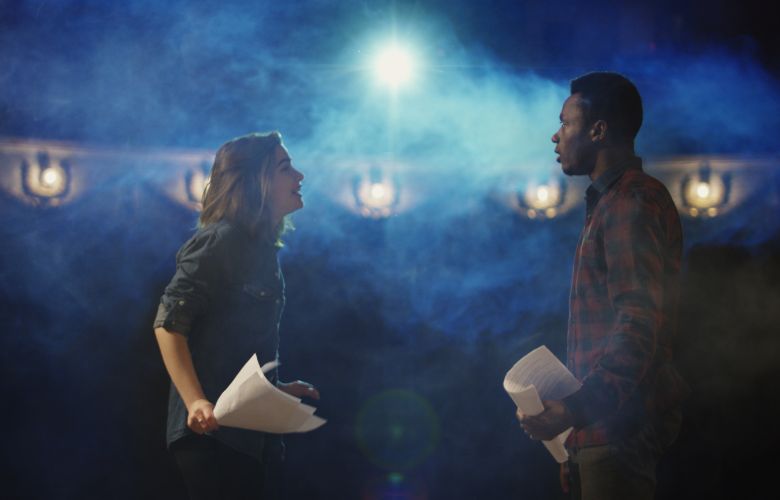
As a Stage Manager, I’ve seen many rehearsals in several different settings. Some have been great and some not so great. I’ve also had the opportunity to work with a variety of different directors and actors in various roles within the rehearsal process. Over time, I’ve noticed that certain aspects of rehearsal are universal across all productions regardless of whether they’re commercial or non-commercial, small or large budgeted, etc.
I’ll share some of those things that could benefit anyone who is interested in becoming involved in theater as a Stage Manager.
The rehearsal process varies greatly depending on the type of production. For example, if you are working on a dance show or a new play, your rehearsal schedule will be very different than if you were working on a musical or an acrobatic-focused circus show. In this section, we’ll break down some common rehearsal schedules for regional theatre and broadway productions.
So what does it mean to be “rehearsing?” This can include anything from blocking scenes and numbers to learning lines or staging scenes with props and sets in place. The director may also have notes they want to be addressed before moving forward with each new scene (e.g., “make sure there’s space between these two actors when they first enter.”).
These competing priorities can make it hard to have all of the necessary people in those rooms at the same time. Usually, it won’t be possible to have everyone there, but with the majority of people there and fill in the gaps later. I’ll typically have a conversation with the director (and directing team if there are associates and assistants) about what they want to accomplish for the day and make a plan together. Most of the time, our plan shifts throughout the day and week. It’s important to be flexible and have a backup plan whenever that happens.
A typical rehearsal process can vary in length. The main factor considered in planning rehearsals is whether it is a brand-new production or something that has been done before. Even if it has been done before, it can be re-imagined–like Shakespeare, which is often done from new perspectives all of the time. Most rehearsal periods range from 3-6 weeks and are impacted by the budget allowed by the producers (or producing organization). Large-scale shows usually go into a creation period where they create the show with all of the performers, designers, technicians, and their support teams from day one. These can last months to years. Other non-scripted productions such as ballet or a dance piece will often be choreographed and rehearsed in a studio off-site and then be brought into a performance space with the creative team and supporting staff for a shorter technical rehearsal time, at times as little as a few hours.
The most important variable to consider when creating a rehearsal schedule is time. How much time do we have to rehearse? What do we want to accomplish with the time we have? What are we able to accomplish with the time we have? And do we all agree? It is a living document and a guide, not a directive.
Actors like the rest of us who work in other areas of production are human beings. And as such, they have bad days just like everyone else. I see the work they do as such a vulnerable act. They have to tap into an emotional place and live onstage so exposed in front of other people. That takes a lot of courage.
It means that actors are sometimes in a sensitive mind and emotional state. It creates an interesting dynamic and one that must be navigated with great care so that we can support their work while also creating a safe space with the structure for them to succeed. This isn’t to say that all actors are difficult people; in fact, most are very easygoing and wonderful people who make a living doing what they love. But even the easy-going actor can have an off day now and then, and that’s where stage managers come in: we help make their journey through it easier with communication and support.
A part of our job as Stage Managers is to keep the acting company in good spirits, and that often means doing everything and anything within reason to help keep them focused on their performance. We make sure they have props when they need them, we cue everyone in the right places at the right times, and we talk them through their lines if they forget what they’re doing. We also coordinate with them behind the scenes so that no one misses their cues or gets left out of a scene, especially during a technical rehearsal. It’s really about communication and not leaving anyone out of the conversation, especially the actors. I’ve observed that sometimes this piece of communication often gets forgotten. It goes a long way when you include actors in the conversation even if it doesn’t directly involve them.
Production meetings are an integral part of the rehearsal process because it’s when the director, producers, designers, technical directors, shop forepeople, and stage managers come together and are able to plan ahead and collaborate while the actors are rehearsing the show. These often happen outside of rehearsal hours. During the meeting, everything is fair game and often will include conversations about what the script dictates, how wardrobe choices influence character development and motivation, blocking (the way you move on stage), and what technical requirements might restrict what the actors are exploring in the rehearsal process. They’ll also discuss all of the design elements along the way as they start to come together as a single unit. Reporting and sharing information that is coming out of the rehearsal process is paramount for designers because they are often working off-site and rely on well-reported information from the stage management team.
Being prepared is key: have everything ready that you need during the meeting so that if anyone asks for anything specific they can look at it right away! Anticipating the needs of the team goes a long way.
Designers are like any other team members. They have different personalities, approaches, and how they like to work; they need to work together as a cohesive design team to create the show. As Stage Managers, we are responsible for making sure they communicate with each other on timeframes and projects such as set construction, lighting placements, practical speakers, rehearsal needs for the director and actors, wardrobe fittings, wig fittings, and about requests and questions that might come up during rehearsal. The main tool for collecting this information for everyone is a rehearsal report.
Designers should also have the agency to communicate with each other without passing through you first–this helps keep things moving smoothly without having to wait for approval or wait until someone has time available before beginning work on an item in question.
The rehearsal process is a great way to learn about the play and the actors, as well as all of the people involved in putting it together. You’ll get an up-close look at how each person works, which can be helpful in many ways. Sometimes this can create unwelcomed conflict.
You may discover that one designer has a unique way of doing things that you would like to incorporate into your own work. Or maybe there’s an actor who doesn’t seem quite right for their role, but they’d make a fantastic understudy (or even a replacement). The rehearsal process gives you time to consider these things before making any final decisions about casting or design choices–and gives everyone else involved with the production plenty of time to assess choices, designs, and how they are responding to the way the actors are living in the world.
The rehearsal process is a very important part of the production. It’s where all the pieces start to come together and you get to see how everything works physically on stage. As a Stage Manager, it’s our job to make sure that everything goes smoothly during these rehearsals so that when technical rehearsals, previews, and performances come around there won’t be any surprises! Being open to the moment and changes that will make the production better is an important skill to foster and keeping an open mind to other perspectives.
I’ll be breaking down some of these points in more detail and discussing pieces that I identify to be the most important parts of the rehearsal phase of production.
SMA Discussion USA-Hong Kong: On Being a Stage Manager (Part 1)


Bryan Runion is a professional Production Stage Manager whose credits include: Drawn to Life (Cirque du Soleil and Disney), Netflix’s Stranger Things: The Experience, Duel Reality (7 Fingers), La Perle (Dragone), The Voice of Tolerance (The Ministry of Education, UAE); Mastercard Experiences (Mastercard); Everybody Black (World Premiere), Queens (La Jolla Playhouse), Ken Ludwig’s The Gods of Comedy (The Old Globe), TEDx (Chula Vista), Mark Morris Dance Company, Joey Alexander Trio, Ukulele Orchestra of Great Britain (La Jolla Music Society), The Bridges of Madison County (Arkansas Rep). Bryan earn his M.F.A. at The University of California, San Diego and his B.A. at The University of Arkansas at Little Rock. He is a proud member of Actors’ Equity Association and The Stage Managers’ Association.
Read Full Profile© 2021 TheatreArtLife. All rights reserved.

Thank you so much for reading, but you have now reached your free article limit for this month.
Our contributors are currently writing more articles for you to enjoy.
To keep reading, all you have to do is become a subscriber and then you can read unlimited articles anytime.
Your investment will help us continue to ignite connections across the globe in live entertainment and build this community for industry professionals.